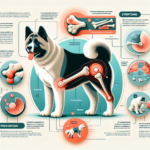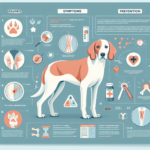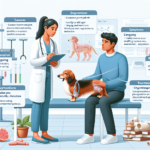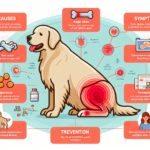Akita Joint Pain: Causes, Symptoms, Prevention, and Treatment

Introduction
The Akita is a large and powerful breed known for its loyalty, intelligence, and striking appearance. Originating from Japan, the Akita was initially bred for hunting large game such as bears, boars, and deer. Over time, the breed has evolved into a versatile companion, excelling in various roles from guard dog to family pet. Akitas are characterized by their thick double coat, erect ears, and curled tail, which give them a distinctive and noble look.
While Akitas are generally robust and healthy, they are not immune to certain health issues. Common concerns include autoimmune diseases, hypothyroidism, and various skin conditions. However, one of the most significant health challenges faced by Akitas is joint pain, which can severely impact their quality of life.
Joint health is particularly crucial for Akitas due to their size and active nature. Poor joint health can lead to debilitating conditions that not only cause pain but also limit mobility and overall well-being. Understanding the causes, symptoms, prevention, and treatment of joint pain in Akitas is essential for ensuring a long, healthy, and happy life for these magnificent dogs.
Breed-Specific Joint Pain Risks
Genetic Predisposition
Akitas are genetically predisposed to several joint-related issues, including hip dysplasia, elbow dysplasia, and arthritis. Hip dysplasia is a condition where the hip joint does not fit properly into the hip socket, leading to pain and mobility issues. Elbow dysplasia involves abnormal development of the elbow joint, causing lameness and discomfort. Arthritis, a degenerative joint disease, is also common in Akitas, particularly as they age.
Age-Related Risks
As Akitas age, the risk of developing joint pain increases. Senior Akitas are more susceptible to arthritis and other degenerative joint conditions. Typically, signs of joint pain may start to appear around the age of 5 to 7 years, although this can vary depending on the individual dog and its genetic background.
Activity Level and Joint Stress
Akitas are known for their high energy levels and need for regular exercise. While physical activity is essential for their overall health, excessive or inappropriate exercise can put undue stress on their joints. Activities such as jumping, running on hard surfaces, or engaging in high-impact sports can exacerbate joint issues, especially in dogs that are already predisposed to such conditions.
Common Symptoms of Joint Pain in Akitas
General Symptoms
- Limping or favoring one leg
- Stiffness, especially after rest or sleep
- Reluctance to move, jump, or climb stairs
- Decreased activity or playfulness
- Swelling around the joints
- Visible discomfort or pain when touched
Breed-Specific Symptoms
In Akitas, joint pain may manifest more prominently due to their size and weight. Owners may notice a significant decrease in their dog’s willingness to engage in activities they once enjoyed. Additionally, Akitas may exhibit a more pronounced limp or stiffness compared to smaller breeds, making it easier to identify joint issues early on.
When to Consult a Vet
If you observe any of the above symptoms in your Akita, it is crucial to consult a veterinarian promptly. Early diagnosis and intervention can significantly improve the prognosis and quality of life for your dog. Persistent limping, noticeable pain, or any sudden changes in behavior should be addressed by a professional to rule out or confirm joint-related issues.
Preventive Measures for Joint Health
Exercise Recommendations
Regular, moderate exercise is essential for maintaining joint health in Akitas. Activities such as walking, swimming, and controlled play can help keep their joints flexible and muscles strong without causing excessive stress. Avoid high-impact activities like jumping or running on hard surfaces, especially for young puppies and older dogs.
Dietary Suggestions
A balanced diet rich in essential nutrients can support joint health in Akitas. Consider incorporating foods or supplements that contain glucosamine, chondroitin, and omega-3 fatty acids, which are known to promote joint health. High-quality commercial dog foods often include these nutrients, but consult your veterinarian for specific dietary recommendations tailored to your dog’s needs.
Weight Management
Maintaining a healthy weight is crucial for reducing joint stress in Akitas. Excess weight can exacerbate joint issues and lead to more severe pain and mobility problems. Monitor your dog’s weight regularly and adjust their diet and exercise routine as needed to keep them within a healthy weight range.
Early Screening and Monitoring
Regular veterinary check-ups and early screening for joint issues can help catch problems before they become severe. For Akitas, consider screening for hip and elbow dysplasia, especially if you plan to breed your dog. Early detection allows for timely intervention and better management of joint health.
Treatment Options for Joint Pain
Non-Surgical Treatments
Non-surgical treatments for joint pain in Akitas include medications, physical therapy, and lifestyle adjustments. Anti-inflammatory drugs and pain relievers can help manage symptoms, while physical therapy can improve mobility and strengthen muscles around the joints. Lifestyle changes, such as providing a comfortable bed and avoiding strenuous activities, can also alleviate joint pain.
Surgical Options
In severe cases, surgical intervention may be necessary to address joint pain in Akitas. Common surgical options include hip replacement, arthroscopy, and joint fusion. These procedures can significantly improve the quality of life for dogs with advanced joint issues, but they come with risks and require a thorough discussion with your veterinarian.
Alternative Therapies
Alternative treatments such as acupuncture, hydrotherapy, and massage can also benefit Akitas with joint pain. Acupuncture can help reduce pain and inflammation, while hydrotherapy provides low-impact exercise that strengthens muscles without stressing the joints. Massage therapy can improve circulation and relieve muscle tension, contributing to overall joint health.
Lifestyle and Management Tips
Daily Care Routine
A consistent daily care routine can help manage and alleviate joint pain in Akitas. This routine might include gentle exercise, a balanced diet, and regular administration of any prescribed medications or supplements. Monitoring your dog’s behavior and adjusting their activities based on their comfort level is also essential.
Modifying the Home Environment
Making your home more comfortable for an Akita with joint pain can significantly improve their quality of life. Consider adding ramps to help them navigate stairs, providing orthopedic beds for better joint support, and placing non-slip mats on slippery surfaces to prevent falls.
Long-Term Management
Long-term management of joint pain in Akitas involves ongoing monitoring and adjustments to their care routine. Regular veterinary check-ups, maintaining a healthy weight, and providing appropriate exercise are key components. Additionally, staying informed about new treatments and therapies can help you make the best decisions for your dog’s joint health.
FAQs About Akitas and Joint Pain
What are the early signs of joint pain in Akitas?
Early signs of joint pain in Akitas include limping, stiffness, reluctance to move, and decreased activity levels. If you notice any of these symptoms, consult your veterinarian for a thorough evaluation.
Can joint pain in Akitas be prevented?
While genetic predispositions cannot be entirely prevented, maintaining a healthy weight, providing appropriate exercise, and ensuring a balanced diet can significantly reduce the risk of joint pain in Akitas.
Are there specific exercises that are better for Akitas with joint pain?
Low-impact exercises such as walking and swimming are ideal for Akitas with joint pain. These activities help maintain muscle strength and joint flexibility without causing excessive stress.
What dietary supplements can help with joint health in Akitas?
Supplements containing glucosamine, chondroitin, and omega-3 fatty acids are beneficial for joint health in Akitas. Consult your veterinarian for specific recommendations based on your dog’s needs.
When should I consider surgery for my Akita’s joint pain?
Surgery should be considered when non-surgical treatments are no longer effective, and your dog’s quality of life is significantly impacted. Discuss the risks and benefits with your veterinarian to make an informed decision.
Conclusion
Joint pain is a significant concern for Akitas, given their size, activity level, and genetic predispositions. Understanding the causes, symptoms, prevention, and treatment options is crucial for ensuring your Akita’s joint health and overall well-being. By taking proactive measures such as maintaining a healthy weight, providing appropriate exercise, and seeking early veterinary intervention, you can help your Akita lead a long, happy, and pain-free life. Regular consultations with your veterinarian and staying informed about new treatments and therapies will further support your efforts in managing your dog’s joint health effectively.




